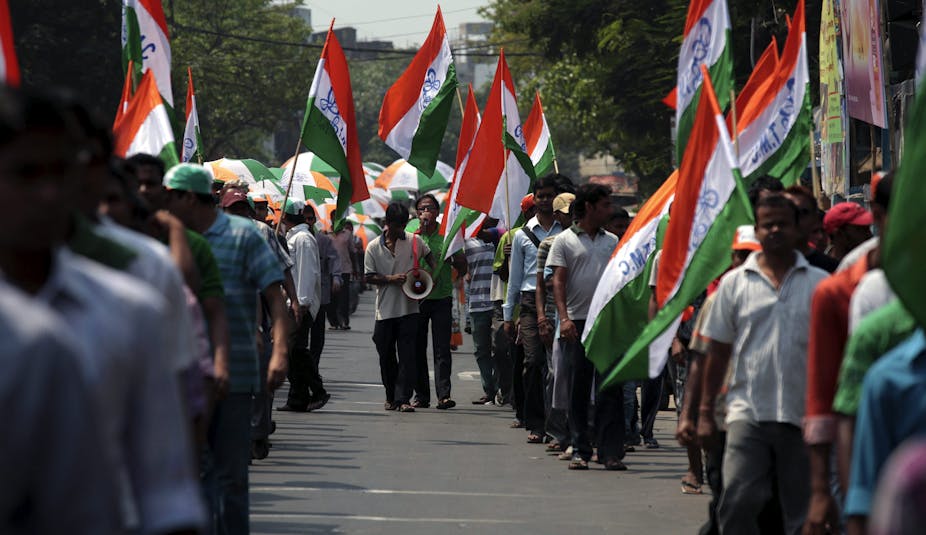Voting in the world’s largest democracy is under way. Indians, an electorate of over 800 million, are casting ballots for their direct representatives to the Lok Sabha (lower house), which completes its term on May 31. At that point India will have a new prime minister, who will be poised to shape the nature of this Asian Century.
Much will depend on India’s engagement with the rest of the world. But foreign policy has never dominated Indian elections. The recently released manifestos from India’s major political parties provide scant substance on the topic.
The Congress Party manifesto
The incumbent Congress Party remains:
…committed to building peaceful, stable and mutually beneficial relations with all major powers and all our Asian neighbours.
In a nostalgic nod to global ties of less recent decades, Congress intends to “support the goodwill nurtured for decades amongst socialist countries”. The manifesto includes obligatory mentions of improving relationships with Pakistan and China, while also acknowledging the border disputes and issues of terrorism that muddy these relationships. Like its manifesto, the Congress Party is widely viewed to be out of ideas.
The Bharatiya Janata Party (BJP), led by Hindu nationalist flag-bearer Narendra Modi, released its manifesto when elections were already underway on April 7. That sent the message that manifestos don’t even matter.
The BJP is running on Modi’s personal character and on his record of development as chief minister of Gujarat. Although many social indicators suggest Gujarat is no model for national development, and Modi’s disastrous custodianship of the horrific 2002 Gujarat violence raises unanswered questions about his character, Modi-as-strategy seems to be a winner for the BJP.
Current polls indicate the strong likelihood of a BJP-led coalition government in New Delhi, with Modi as prime minister.
BJP’s manifesto
The Congress manifesto’s curious nod to Cold-War-era global configurations contrasts with the BJP’s obsession with pre-modern times as a basis for 21st-century foreign policy. The BJP conception of recent history tells that Congress rejected India’s true heritage by blindly adopting a British administrative framework, demonstrating Congress’s unwillingness to recreate the prominent status of Hindu India in ancient global society.
The BJP manifesto declares its own foreign policy would be guided by millennia of Indian tradition, beginning with the principle of वसुधैव कुटुम्बकम्. This Sanskrit phrase declaring the earth to consist of a single family is a motto of the Rashtriya Swayamsevak Sangh, the Hindu Nationalist group with close BJP ties.
Because India’s ancient roots provide the foundation for a BJP global outlook, India’s foreign policy would also be guided by the “spiritual, cultural and philosophical” dimensions of India’s soft power. The might of this imagined premodern India simultaneously provides a basis for a multi-pronged and aggressive approach to terrorism:
We will not hesitate from taking strong stances and steps.
Implications for Australia
Much of India’s foreign policy is guided by its relationship with its closest neighbours. By contrast, Australia’s relationship with India has often been coloured by the national security interests of the United States. Washington is moving quickly to lift diplomatic restrictions that were placed on Modi over questions about his involvement in the 2002 Gujarat violence.
Australia should not let these restraints, nor the lack of clarity from the BJP regarding what a foreign policy guided by Hindu nationalist concerns would actually look like, distract from monumental Indian domestic shifts that bear on Australia’s relationship with India.
Congress critics blame it for a decade of a slowing economy, a falling value of the rupee and runaway defects: all prompted by the government’s failure to invest in infrastructure and a tendency to focus on unaffordable subsides.
Economists may argue over the effect of subsidies to rural communities that rely on a subsistence living, but one thing is clear. If a future government can shepherd India’s rural communities away from subsistence living, this would present a huge opportunity for Australia. A whole new consumer market would open up.
That market does not speak English. Farmers in rural India are already on Twitter and Facebook, but they are communicating in one of the 22 officially recognised Indian languages (if not one of the hundreds of regional languages). Electoral politics are conducted almost entirely in Hindi. Hinglish – a new language born of English and Hindi – can be unintelligible at times to someone who knows only one of the languages.
The political idiom guiding a document such as the 2014 BJP manifesto can only be understood with a knowledge of India’s history, culture and religious traditions.
The BJP highlights the soft power of the “Five Ts”: tradition, talent, tourism, trade and technology. Australia already engages with India on these levels. University students from India, for example, make up one of the fastest-growing segments of Australia’s international student population.
Australia needs to engage further with this market, and to build deep and broad relationships with India as outlined in the 2013 Australia in the Asian Century White Paper. Australia should continue to highlight the importance of Asian cultural literacy and develop Asian language programs in Australian schools.
While big changes may not be in store for India’s foreign policy, Australia can still continue to engage in the soft diplomacy, Australia’s own five Ts, that will ensure Australia’s place alongside India in shaping the Asian Century.

